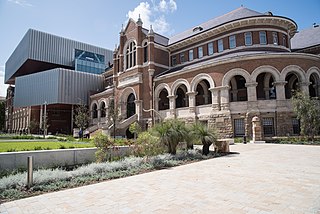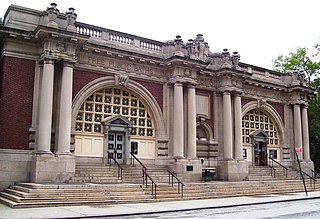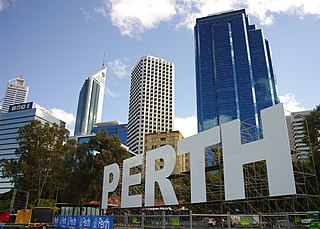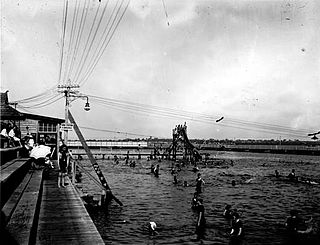
Perth is the capital and largest city of the Australian state of Western Australia (WA). It is the fourth most populous city in Australia and Oceania, with a population of 2.1 million living in Greater Perth in 2020. Perth is part of the South West Land Division of Western Australia, with most of the metropolitan area on the Swan Coastal Plain between the Indian Ocean and the Darling Scarp. The city has expanded outward from the original British settlements on the Swan River, upon which the city's central business district and port of Fremantle are situated. Perth is located on the traditional lands of the Whadjuk Noongar people, where Aboriginal Australians have lived for at least 38,000 years.

In ancient Rome, thermae and balneae were facilities for bathing. Thermae usually refers to the large imperial bath complexes, while balneae were smaller-scale facilities, public or private, that existed in great numbers throughout Rome.

Bathing is the washing of the body with a liquid, usually water or an aqueous solution, or the immersion of the body in water. It may be practiced for personal hygiene, religious ritual or therapeutic purposes. By analogy, especially as a recreational activity, the term is also applied to sun bathing and sea bathing.

The Swan Brewery is a brewing company, whose brewery was located in Perth, Western Australia.

Public baths originated when most people in population centers did not have access to private bathing facilities. Though termed "public", they have often been restricted according to gender, religious affiliation, personal membership, and other criteria. In addition to their hygienic function, public baths have also been social meeting places. They have included saunas, massages, and other relaxation therapies, as are found in modern day spas. As the percentage of dwellings containing private bathrooms has increased in some societies, the need for public baths has diminished, and they are now almost exclusively used recreationally.

Bicton is an affluent riverside suburb of Perth, Western Australia, located 10 kilometres (6.2 mi) south-west of the central business district. The suburb is mostly residential, and falls within the City of Melville local government area. Bicton borders the Swan River to the north, with the northern third of the suburb taken up by a Class-A reserve at Point Walter.

Point Walter is a point on the Swan River, Western Australia, notable for its large sandbar that extends into the river. It is located on the southern shore of Melville Water, and forms its western end. Point Walter is located in the suburb of Bicton, approximately 12 kilometres (7 mi) south of the Perth central business district, and 7 kilometres (4 mi) north-east of Fremantle, and is on the opposite side of the river to the suburbs of Mosman Park, Peppermint Grove, and Dalkeith.

The Birmingham Baths Committee was an organisation responsible for the provision and maintenance of public swimming and bathing facilities. Birmingham City Council funded, constructed and ran bathing facilities throughout the city. The movement to develop baths and wash houses in Britain had its impetus with the rapid urbanisation of the Industrial Revolution, which was felt acutely in Birmingham, one of England's powerhouses.

Cottesloe Beach is a popular beach in Cottesloe and one of the most iconic locations of Western Australia. The enduring popularity of the beach is the result of combinatuon of factors including proximity to metropolitan Perth, accessibility by train, shelter from strong summer breezes and presence of offshore reefs making it a relatively safe swimming location. It has been recognised by the Heritage Council as a place of cultural significance since 2005. Since the beginning of the twentieth century a succession of bathing structures and hotels have been constructed in prominent locations overlooking the beach. The current beach-front structure was constructed in 1996 and is known as the Indiana Teahouse. Designed in a neotraditional architectural style it has become an internationally recognised landmark of Perth. The beach hosts the popular Rottnest Channel Swim, and Sculpture by the Sea. It attracts around 600,000 visitors per year.

The City Baths, located at 420 Swanston Street, Melbourne, Australia, opened in 1904 as public baths, with swimming pools and bathing facilities. Extensively renovated in the early 1980s, it is now considered one of Melbourne's most architecturally and historically significant buildings.

The Swan River Mechanics' Institute was the Swan River Colony's first cultural centre, established on 21 January 1851. In time it was to house an extensive and well-used subscription library and a natural history collection, including botanical, zoological and mineral specimens. A new building replaced the old in 1899, and in 1909 the institute was renamed Perth Literary Institute.

Eliza is a bronze sculpture located in Matilda Bay on the Swan River in Western Australia. The sculpture and plinth are mounted on a steel pylon 15 metres (49 ft) off the shoreline and depicts a woman about to dive off a wooden platform. It commemorates the old Crawley Baths which were a prominent Perth landmark during the early to mid 20th century. The sculpture is 2.2 metres high. The artwork has its own lighting from solar panels.

Claise Brook is a stream which empties into Claisebrook Cove before running into the Swan River in Perth, Western Australia. The area surrounding the stream is on the outskirts of the Perth CBD and is part of the suburb of East Perth. Claise Brook was once an important water course from which the numerous interconnected fresh water lakes north of Perth emptied into during the wet season before entering the Swan River.

The Esplanade Reserve in Perth, Western Australia was a heritage listed public space between Perth Water and the Perth central business district. It formed part of, and was occasionally referred to incorrectly as, the Perth foreshore and the Perth waterfront. The public space was resumed by the Western Australian state government in April 2012 as part of the Elizabeth Quay redevelopment of the Perth waterfront area.

Bunbury Bridge was a single-track, timber railway bridge in East Perth in Western Australia. The bridge crossed the Swan River near Claise Brook and was built for passenger and freight traffic to Bunbury on the South Western Railway.

Elizabeth Quay is a mixed-use development project in the Perth central business district. Focusing on an area located on the north shore of Perth Water near the landmark Swan Bells, the precinct being developed by the project was named in honour of Queen Elizabeth II during her Diamond Jubilee.

Crawley Baths was a public swimming facility, in Matilda Bay, near Crawley, Western Australia along Mounts Bay Road. The timber structure was opened on 7 February 1914. The opening ceremony was conducted by Premier John Scaddan and included a swimming carnival and life saving displays.

Esplanade Park is a public reserve in Fremantle, Western Australia. Situated on Marine Terrace and opposite the Esplanade Hotel, the reserve features about 100 mature Norfolk Island pines and the Explorers' Monument.

The City of Perth Library is a public library service provided by the City of Perth. The library is located on Hay Street, next to the Perth Town Hall. It is part of the redevelopment of Cathedral Square, located between St Georges Terrace and Hay, Barrack and Pier Streets.
Pier Street is a street in the central business district of Perth, Western Australia. It runs from St Georges Terrace to Wellington Street, continuing immediately north of the railway until Brisbane Street very close to where Brisbane Street meets Bulwer Street.




















